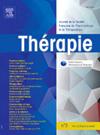Impact délétère d’un anti-inflammatoire non stéroïdien pris pour fièvre ou douleur aiguë en cas d’infection streptococcique
IF 1.8
4区 医学
Q3 PHARMACOLOGY & PHARMACY
引用次数: 0
Abstract
Depuis plusieurs années, les centres régionaux de pharmacovigilance alertent sur le risque d’aggravation des infections bactériennes cutanées ou pulmonaires à streptocoques pyogènes ou à pneumocoques, après la prise d’anti-inflammatoires non stéroïdiens (AINS), notamment l’ibuprofène. Une nouvelle expertise présentée à l’Agence du médicament en 2024 a colligé en 4,5 ans, 216 cas d’infections bactériennes graves (162 avec ibuprofène, 54 avec kétoprofène) après la prise d’AINS pour fièvre ou douleur aiguë, soit environ 21 % des effets indésirables graves avec l’ibuprofène (8 % pour le kétoprofène). Les infections streptococciques étaient majoritaires pour l’ibuprofène (62 % des cas d’infection bactérienne graves ; 44 % pour le kétoprofène). Ces infections streptococciques étaient invasives (97 %), à type de sepsis sévère/choc toxinique, de pleuropneumopathie, de méningite/méningoencéphalite et de dermohypodermite nécrosante. Les études de pharmaco-épidémiologie suggèrent toute une association entre l’exposition à un AINS et une augmentation du risque de complications pleuropulmonaires avec une estimation du risque compris entre 1,8 et 8. Plusieurs données mécanistiques sont également en faveur d’un effet délétère spécifique sur la gravité des infections invasives streptococciques, par un effet propre, intrinsèque des AINS sur l’amplification de la diffusion des streptocoques (via la vimentine). Des études expérimentales, chez l’animal, démontrent également ce risque, même quand l’AINS est associé à un antibiotique. En conclusion, en présence d’une infection streptococcique, qu’elle soit diagnostiquée ou non, la prise d’un AINS pour fièvre ou douleur aiguë, même sur une courte durée, et même associée à un antibiotique est une pratique à risque. Elle favorise l’évolution vers une infection streptococcique plus grave, non seulement en retardant la prise en charge de l’infection, mais surtout en favorisant la dissémination du streptocoque. Dans la mesure où les infections invasives à Streptococcus pyogenes sont un réel problème de santé publique, tout facteur de risque potentiel d’aggravation doit être pris en compte.
For several years, regional pharmacovigilance centers have been warning about the risk of worsening bacterial skin or lung infections caused by Streptococcus pyogenes or Pneumococcus after taking non-steroidal anti-inflammatory drugs (NSAIDs), particularly ibuprofen. A new report submitted to the French Medicines Agency in 2024 documented 216 cases of serious bacterial infections (162 with ibuprofen, 54 with ketoprofen) over 4.5 years following the use of NSAIDs for fever or acute pain. This represents about 21% of serious adverse events with ibuprofen (8% with ketoprofen). Streptococcal infections were most common with ibuprofen (62% of serious bacterial infections; 44% with ketoprofen). These streptococcal infections were invasive (97%) and included severe sepsis/toxic shock, pleuropneumopathy, meningitis/meningoencephalitis and necrotizing dermohypodermatitis. Pharmacoepidemiological studies all suggest an association between NSAID exposure and an increased risk of pleuropulmonary complications, with estimated risks ranging from 1.8 to 8. Several mechanistic data also suggest a specific adverse effect on the severity of invasive streptococcal infections through a specific intrinsic effect of NSAIDs on the enhancement of streptococcal diffusion (via vimentin). Experimental studies in animals have also demonstrated this risk, even when NSAIDs are combined with antibiotics. In conclusion, in the presence of a streptococcal infection, whether diagnosed or not, taking an NSAID for fever or acute pain, even for a short time and even in association with an antibiotic, is a risky practice. It encourages the development of a more serious streptococcal infection, not only by delaying management of the infection, but more importantly by promoting the dissemination of the streptococcus. As invasive S. pyogenes infections are a real public health problem, any potential risk factor for aggravation must be taken into account.
[在链球菌感染的情况下,用于发烧或急性疼痛的非甾体抗炎药的有害影响]。
几年来,区域药物警戒中心一直在警告服用非甾体抗炎药(NSAIDs),特别是布洛芬后,由化脓性链球菌或肺炎球菌引起的细菌性皮肤或肺部感染恶化的风险。2024年提交给法国药品管理局的一份新报告记录了216例严重细菌感染(162例使用布洛芬,54例使用酮洛芬),在使用非甾体抗炎药治疗发烧或急性疼痛的4.5年内。这约占布洛芬严重不良事件的21%(酮洛芬为8%)。链球菌感染在布洛芬中最常见(62%的严重细菌感染;44%服用酮洛芬)。这些链球菌感染是侵袭性的(97%),包括严重败血症/中毒性休克、胸膜肺炎、脑膜炎/脑膜脑炎和坏死性皮炎。药物流行病学研究均表明,非甾体抗炎药暴露与胸膜肺并发症风险增加之间存在关联,估计风险范围为1.8至8。一些机制数据也表明,通过非甾体抗炎药增强链球菌扩散(通过vimentin)的特定内在效应,对侵袭性链球菌感染的严重程度有特定的不利影响。动物实验研究也证明了这种风险,即使非甾体抗炎药与抗生素联合使用也是如此。总之,在链球菌感染的情况下,无论是否确诊,在发烧或急性疼痛时服用非甾体抗炎药,即使是很短的时间,甚至与抗生素有关,都是一种危险的做法。它不仅延误了感染的治疗,而且更重要的是促进了链球菌的传播,从而助长了更严重的链球菌感染的发展。由于侵袭性化脓性链球菌感染是一个真正的公共卫生问题,任何潜在的恶化风险因素都必须考虑在内。
本文章由计算机程序翻译,如有差异,请以英文原文为准。
求助全文
约1分钟内获得全文
求助全文
来源期刊

Therapie
医学-药学
CiteScore
3.50
自引率
7.70%
发文量
132
审稿时长
57 days
期刊介绍:
Thérapie is a peer-reviewed journal devoted to Clinical Pharmacology, Therapeutics, Pharmacokinetics, Pharmacovigilance, Addictovigilance, Social Pharmacology, Pharmacoepidemiology, Pharmacoeconomics and Evidence-Based-Medicine. Thérapie publishes in French or in English original articles, general reviews, letters to the editor reporting original findings, correspondence relating to articles or letters published in the Journal, short articles, editorials on up-to-date topics, Pharmacovigilance or Addictovigilance reports that follow the French "guidelines" concerning good practice in pharmacovigilance publications. The journal also publishes thematic issues on topical subject.
The journal is indexed in the main international data bases and notably in: Biosis Previews/Biological Abstracts, Embase/Excerpta Medica, Medline/Index Medicus, Science Citation Index.
 求助内容:
求助内容: 应助结果提醒方式:
应助结果提醒方式:


